If you’re looking for a versatile and effective way to exercise, you may want to consider incorporating kettlebells into your workouts. These unique pieces of fitness equipment have been around for centuries and have recently gained popularity in the fitness world. Kettlebells are ideal for full-body workouts because they can be used to target multiple muscle groups simultaneously, providing a total-body workout in a shorter amount of time.
What are Kettlebells?
Kettlebells are essentially weighted balls with handles attached to them. They come in various sizes and weights, ranging from a few pounds to over 100 pounds. Kettlebells are made from iron or steel and are shaped like a cannonball with a flat base and a curved handle that allows for a comfortable grip.
History of Kettlebells
The history of kettlebells can be traced back to Russia in the 1700s when they were used as a tool for weighing crops. However, it wasn’t until the early 1900s that kettlebells began to be used for physical training purposes. Russian soldiers and athletes began incorporating kettlebells into their training routines, which helped to develop their strength, power, and endurance.
Benefits of Kettlebell Training
Kettlebell training offers a wide range of benefits, including improved strength, endurance, flexibility, and cardiovascular health. Because kettlebells require you to use multiple muscle groups at once, they provide a total-body workout that can help you achieve your fitness goals faster than traditional weight training.
1. Full-Body Workout
One of the main benefits of kettlebell training is that it provides a full-body workout. Kettlebell exercises engage multiple muscle groups at once, which means you can get a complete workout in a shorter amount of time. Whether you’re swinging the kettlebell or doing squats and lunges, you’ll be working your legs, core, back, and arms all at the same time.
2. Builds Strength and Muscle
Another major benefit of kettlebell training is that it helps build strength and muscle. Because kettlebell exercises engage so many muscle groups at once, they’re an efficient way to increase strength and build muscle. Plus, kettlebell exercises often involve movements that require you to stabilize your body, which can help improve your overall balance and coordination.
3. Burns Fat and Increases Endurance
Kettlebell training is also great for burning fat and increasing endurance. Because kettlebell exercises are typically high-intensity, they can help you burn more calories in less time. Plus, kettlebell training can help increase your cardiovascular endurance, which can improve your overall health and fitness.
4. Improves Mobility and Flexibility
Kettlebell training can also help improve your mobility and flexibility. Many kettlebell exercises involve movements that require you to move through a full range of motion, which can help improve your joint mobility. Additionally, kettlebell training can help improve your flexibility by stretching your muscles during each exercise.
5. Low-Impact Exercise
If you’re looking for a low-impact exercise option, kettlebell training is a great choice. Unlike running or jumping, kettlebell exercises don’t put a lot of stress on your joints, which can make them a safer option for people with joint pain or injuries.
6. Increases Mental Focus
Kettlebell training can also help increase your mental focus. Because many kettlebell exercises require you to concentrate on your form and technique, they can help improve your focus and concentration. Additionally, the high-intensity nature of kettlebell training can help boost your energy levels and improve your overall mood.
7. Versatile Workout
Another great thing about kettlebell training is that it’s a versatile workout. There are countless exercises you can do with a kettlebell, which means you can switch up your routine and target different muscle groups depending on your goals. Plus, kettlebells come in a variety of weights, so you can start with a lighter weight and work your way up as you get stronger.
8. Cost-Effective
Finally, kettlebell training is a cost-effective exercise option. Unlike a gym membership or personal training sessions, you only need one or two kettlebells to get started with kettlebell training. Plus, kettlebells are relatively affordable compared to other workout equipment, which makes them an excellent investment for your home gym.
Kettlebells for Full-Body Workouts
Kettlebell exercises are a great way to incorporate full-body workouts into your fitness routine. The unique shape of the kettlebell allows for a range of exercises that target multiple muscle groups at once, making it an efficient and effective tool for getting a full-body workout.
Here are a few examples of kettlebell exercises that can be incorporated into a full-body workout routine, along with tips on how to perform them correctly to maximize their benefits.
Before we dive into the exercises, it’s important to remember that form is key. Improper technique can lead to injury and prevent you from getting the most out of your workout. Here are some tips to keep in mind when performing kettlebell exercises:
- Keep your core engaged. Your core muscles are essential for stabilizing your body during kettlebell exercises. Engage your abs and glutes to maintain proper form and prevent injury.
- Use your legs. Many kettlebell exercises require you to use your legs to generate power. Make sure you’re using your legs to drive the movement, rather than relying solely on your arms and shoulders.
- Start with a lighter weight. It’s better to start with a lighter weight and focus on proper form than to try to lift too much too soon. You can always increase your weight as you get stronger and more comfortable with the exercises.
- Ensuring adequate breathing is vital for sustaining energy levels and avoiding exhaustion while performing kettlebell exercises. To achieve this, take a deep breath in as you get ready for the movement and exhale as you carry out the movement.
Now, let’s explore four kettlebell exercises that will give you a full-body workout:
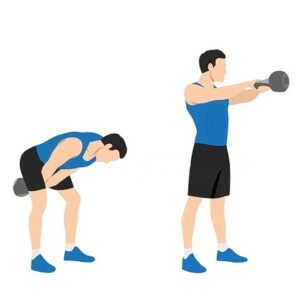
Kettlebell Swing
The Kettlebell swing is an excellent exercise that targets multiple muscle groups in your body, including the hamstrings, glutes, and back muscles. It is a highly effective exercise that can help you build strength, improve endurance, and burn fat. However, like any other exercise, performing the kettlebell swing incorrectly can lead to injury and render the exercise ineffective. Here are some tips on how to perform the kettlebell swing exercise correctly.
Start with the right weight:
The first step to performing the kettlebell swing correctly is choosing the right weight. It is essential to choose a weight that is comfortable for you, but challenging enough to give you a workout. As a beginner, start with a lightweight and gradually work your way up to heavier weights.
Stand with proper posture:
Maintaining a correct posture is essential when executing a kettlebell swing. To do this, ensure that your feet are positioned shoulder-width apart with your knees slightly bent. Ensure that your back is straight and your core is activated. Also, make sure your shoulders are relaxed, and your chest is lifted throughout the exercise.
Use your hips:
The kettlebell swing is primarily a hip hinge movement. To perform the exercise correctly, hinge your hips back and forth. Keep your arms straight, and your grip firm on the kettlebell. Use your hips to drive the kettlebell forward and upward, while maintaining weight control.
Don’t use your arms:
It’s common for people to improperly use their arms to lift the kettlebell when performing a swing, which can result in injury. It’s crucial to avoid this mistake by keeping the arms straight throughout the exercise. Instead, utilize the momentum generated by the hips to lift the kettlebell properly.
Use proper breathing techniques:
Breathing is an essential aspect of the kettlebell swing exercise. Inhale as you hinge your hips back and exhale as you drive your hips forward to lift the kettlebell. This breathing pattern helps to stabilize your core and improve your performance.
Avoid rounding your back:
Rounding your back during the kettlebell swing exercise can lead to injury. It is crucial to keep your back straight and engage your core muscles to maintain proper form throughout the exercise.
Kettlebell swing exercise is an excellent way to build strength, endurance and burn fat. To perform the exercise correctly, it is crucial to start with the right weight, stand with proper posture, use your hips to generate momentum, avoid using your arms, use proper breathing techniques, and avoid rounding your back.
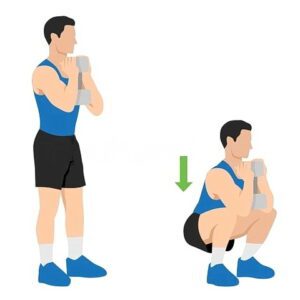
Goblet Squat
The goblet squat is a popular exercise that is great for building lower body strength and improving your overall fitness. This exercise involves holding a weight close to your chest while you perform a squat. It is an effective exercise for targeting your glutes, quads, hamstrings, and core. If you are looking to incorporate this exercise into your workout routine, here are some tips on how to perform it correctly:
Start by choosing an appropriate weight:
You can use a kettlebell, dumbbell, or any other weighted object that you can hold close to your chest. It is important to choose a weight that is challenging but manageable. You should be able to perform the exercise with proper form without feeling like the weight is too heavy.
Proper form:
Stand with your feet shoulder-width apart and hold the weight close to your chest with both hands. Keep your elbows tucked in and your core engaged.
Lower your body:
Lower your body into a squat by bending your knees and pushing your hips back. Keep your chest up and your back straight throughout the movement. Make sure your knees do not cave inwards.
Go as low as you can while maintaining proper form:
Your thighs should be parallel to the ground or lower if possible.
Push through your heels:
Push through your heels and squeeze your glutes to return to the starting position. Exhale as you rise.
Repeat:
Repeat for the desired number of repetitions.
Here are some additional tips to keep in mind:
– Make sure your weight is evenly distributed between your feet.
– Keep your head up and your gaze forward throughout the exercise.
– If you are new to the goblet squat, start with a lighter weight and focus on mastering the proper form before increasing the weight.
– If you have any knee or back issues, consult with a healthcare professional before performing this exercise.
– Incorporate goblet squats into your workout routine 2-3 times a week for best results.Make sure to keep your chest up and your core engaged throughout the movement. You can also experiment with different foot positions to target different areas of your legs.
Remember to choose an appropriate weight, maintain proper form, and gradually increase the weight as you get stronger.
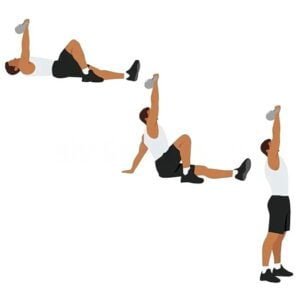
Turkish Get-Up
The Turkish Get-Up is a fantastic exercise that engages the entire body, improving strength, mobility, and coordination. This movement is a combination of several exercises that require stability and control in multiple planes of motion. The Turkish Get-Up is a challenging exercise that requires patience and practice to perform correctly. Here are some tips on how to perform this exercise safely and effectively.
Start with a lightweight:
The Turkish Get-Up is a complex movement that requires a lot of concentration and attention to detail. Begin with a lightweight to focus on the technique and gradually progress as you feel comfortable.
Get into the correct starting position:
Begin by lying on your back with your knees bent, and your feet flat on the ground. Hold the weight with one hand, and extend your arm towards the ceiling. Keep your eyes on the weight.
Roll onto your side:
Roll onto your side, with the arm holding the weight pointing towards the ceiling. Prop yourself up onto your elbow using your other hand.
Push up onto your hand:
Push up onto your hand, keeping your arm extended towards the ceiling, and your eyes on the weight.
Lift your hips:
Lift your hips off the ground, so that your weight-bearing hand is supporting your body weight. Always keep your eyes on the weight.
Sweep your leg:
Sweep your opposite leg behind you, so that your knee is resting on the ground. Your non-weight-bearing arm should be extended out to the side.
Stand up:
Stand up, keeping your eyes on the weight, and your arm extended towards the ceiling.
Reverse the movement:
Reverse the movement, following the same steps back to the starting position.
Breathe:
Take a deep breath in as you begin the movement, and exhale as you lift your body off the ground.
Keep your core engaged:
Throughout the movement, engage your core muscles to maintain stability and control.
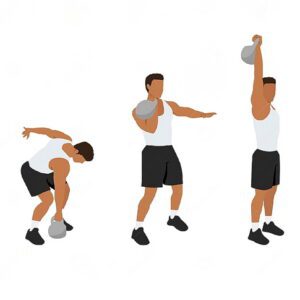
Kettlebell Clean and Press
The Kettlebell clean and press exercise is a compound movement that targets several muscles in your body. It involves lifting a kettlebell from the ground to your shoulder and then pushing it overhead with one arm. It’s an excellent exercise for building upper body strength, improving mobility, and burning calories.
However, to perform the kettlebell clean and press exercise correctly, you need to master the proper form and technique. The following are the steps involved in performing the exercise correctly and give you tips to avoid common mistakes.
Start with a suitable weight:
Before you start the exercise, choose a kettlebell that’s appropriate for your fitness level. If you’re a beginner, start with a lighter kettlebell and progress to heavier weights as you gain strength and confidence. Ideally, a weight that you can lift for 8-12 reps with proper form is ideal.
Stand with your feet hip-width apart:
Stand with your feet shoulder-width apart, toes pointing slightly outwards. Maintain a straight back, with your chest up and shoulders down.
Pick up the kettlebell:
Bend down and grip the kettlebell handle with one hand, with your palm facing towards you. Keep your arm straight, and lift the kettlebell off the ground by driving your hips forward, keeping your back straight.
Clean the kettlebell to your shoulder:
As the kettlebell reaches your waist, explosively extend your hips and knees to drive the kettlebell upward. As the kettlebell approaches your shoulder, tuck your elbow close to your body, allowing the kettlebell to rotate around your wrist, and catch it at the top of your shoulder.
Press the kettlebell overhead:
With your core engaged, press the kettlebell upward using your shoulder and triceps muscles until your arm is fully extended. Keep your elbow locked and your wrist straight throughout the movement.
Lower the kettlebell:
Lower the kettlebell back to your shoulder by bending your elbow and slowly bringing the kettlebell down to the starting position.
Repeat the exercise:
Complete the desired number of repetitions before switching to the other arm.
Tips to Perform the Kettlebell Clean and Press Exercise Correctly
Here are some tips to help you perform the kettlebell clean and press exercise correctly:
1- Focus on your form and technique, not the weight lifted.
2- Keep your core tight and your glutes engaged throughout the exercise.
3- Keep your wrist straight throughout the movement to avoid injury.
4- Avoid shrugging your shoulders as you lift the kettlebell.
5- Exhale as you lift the kettlebell and inhale as you lower it.
6- Start with a lighter kettlebell if you’re a beginner and progress to heavier weights gradually.
7- Practice the movement with a coach or a personal trainer to ensure proper form and technique.
The kettlebell clean and press exercise is a challenging but rewarding exercise that can help you build upper body strength, improve mobility, and burn calories. Performing this exercise safely and effectively is achievable by following the proper form and technique. Remember to start with a lighter weight, focus on your form, and progress gradually to heavier weights.
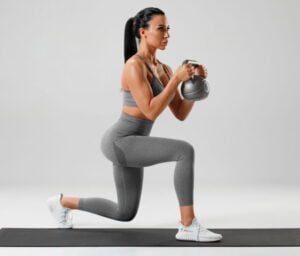
Kettlebell Lunges
The Kettlebell lunges are an effective full-body exercise that can help you build strength, stability, and improve your balance. They target your legs, hips, glutes, and core muscles, making them an ideal exercise for anyone looking to improve their lower body strength and overall fitness.
Here are some tips on how to perform the kettlebell lunges exercise correctly:
Choose the right kettlebell weight:
When selecting a kettlebell weight, choose a weight that you can handle with good form for the entire set. Begin with a lighter weight and steadily raise it as you get more comfortable with the exercise.
Start with proper posture:
Begin by standing straight with your feet shoulder-width apart. Hold the kettlebell in both hands at chest height with your elbows bent and close to your body.
Step forward with one foot:
Take a large step forward with one foot, keeping your back straight and your core engaged. Ensure that your front knee is directly above your ankle, while your back knee hovers just above the ground.
Press the kettlebell overhead:
As you lunge forward, press the kettlebell overhead, keeping your arms straight and your core tight. Ensure that your shoulders are relaxed and away from your ears.
Return to the starting position:
Push off your front foot to return to the starting position, bringing the kettlebell back to chest height. Perform the lunge again with the other leg.
Repeat for multiple sets:
Aim to complete three to four sets of 8 to 12 repetitions on each leg, resting for 30 to 60 seconds between sets.
Some additional tips to keep in mind while performing the kettlebell lunges exercise:
– Keep your core engaged throughout the exercise to maintain stability and avoid straining your lower back.
– Maintain relaxed and downward shoulders throughout the exercise.
– Make sure to step far enough forward to create a 90-degree angle between your front thigh and shin.
– Avoid letting your front knee go past your toes while lunging.
– Maintain proper form and avoid leaning too far forward or backward while lunging.
The kettlebell lunges exercise is an effective way to build lower body strength, stability, and balance. By following these tips and incorporating kettlebell lunges into your workout routine, you can improve your overall fitness and achieve your fitness goals. Always remember to prioritize good form to prevent injury, and start with a lighter weight, gradually increasing it as you become more comfortable with the exercise.
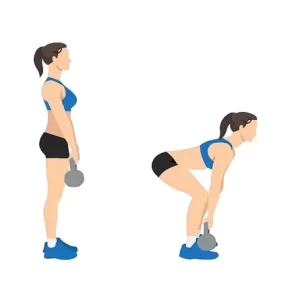
Kettlebell Deadlift
The kettlebell deadlift is an excellent exercise that targets several muscle groups in the body, including the glutes, hamstrings, quads, and lower back. It’s a popular movement among fitness enthusiasts and athletes due to its versatility, convenience, and effectiveness. However, like any other exercise, performing the kettlebell deadlift correctly is crucial to reap its benefits and avoid injury. In this section, we’ll discuss tips on how to perform the kettlebell deadlift exercise correctly.
Before we dive into the tips, it’s essential to understand the correct form and technique of the kettlebell deadlift. The kettlebell deadlift involves standing with your feet shoulder-width apart, gripping the kettlebell handle with both hands and lifting the kettlebell from the ground to a standing position while maintaining a neutral spine and engaged core. The movement involves a hip hinge, where you push your hips back while keeping your knees slightly bent and your chest up. Once you’ve lifted the kettlebell, you should lower it back to the ground with control, keeping the same form and technique as the upward movement.
Now that you understand the basic movement, let’s look at the tips on how to perform the kettlebell deadlift correctly:
Start light:
If you’re new to the kettlebell deadlift, it’s best to start with a lighter weight to practice the correct form and technique. As you progress, you can gradually increase your weight.
Keep your back neutral:
Maintaining a neutral spine is essential to avoid injury and engage the correct muscles. Avoid rounding your back or arching it excessively.
Engage your core:
Engaging your core muscles will help stabilize your spine and prevent injury. Keep your abs tight throughout the movement.
Push your hips back:
The kettlebell deadlift involves a hip hinge movement, where you push your hips back while keeping your knees slightly bent. This movement engages your glutes and hamstrings.
Keep the kettlebell close to your body:
As you lift the kettlebell, keep it as close to your body as possible. This will help you maintain proper form and avoid strain on your lower back.
Control the movement:
Lower the kettlebell back to the ground with control, maintaining the same form and technique as the upward movement. Avoid dropping the weight or jerking it.
In addition to these tips, here are some common mistakes to avoid:
– Don’t round your back when picking up the kettlebell. This can put unnecessary strain on your lower back and increase your risk of injury.
– Don’t let your shoulders roll forward. Keep them pulled back and down throughout the exercise.
– Don’t let the weight pull you forward. Keep your weight balanced between your feet.
Overall, the kettlebell deadlift exercise is a great way to strengthen your lower body and improve your overall fitness. By following these tips and avoiding common mistakes, you can perform the exercise correctly and safely. As with any new exercise, start slowly and gradually increase the weight as you become more comfortable with the movement.
In conclusion, kettlebells are an excellent tool for achieving a full-body workout. They are versatile, compact, and provide a range of benefits for strength, cardio, and flexibility training. Incorporating kettlebells into your workout routine can help you build endurance, increase strength, and burn calories in a short amount of time. Kettlebell exercises work for multiple muscle groups simultaneously, making them a time-efficient way to achieve a full-body workout. With proper form and technique, kettlebells can also help improve posture, balance, and coordination. So if you’re looking to switch up your workout routine or challenge yourself in new ways, give kettlebells a try and experience the full-body benefits they have to offer.

Leave a Reply